About Frequency Factor Calculator (Formula)
A Frequency Factor Calculator helps in determining the frequency factor (FF) in chemical reactions, especially within the context of the Arrhenius equation. This factor represents the number of times reactant molecules collide in a way that leads to a successful reaction. Knowing the frequency factor is essential for predicting reaction rates, making it vital in the fields of chemistry and chemical engineering.
Formula
The formula to calculate the frequency factor (FF) is:
FF = K / e^(-Ea / (R * T))
Where:
- K is the pre-exponential factor
- Ea is the activation energy
- R is the universal gas constant
- T is the temperature (in Kelvin)
- e is the base of the natural logarithm (approximately 2.718)
How to Use
To use a Frequency Factor Calculator:
- Input the pre-exponential factor (K), activation energy (Ea), universal gas constant (R), and temperature (T) into the calculator.
- The calculator will process these inputs and apply them to the frequency factor formula.
- The result will give the frequency factor, which indicates the rate at which molecules successfully collide in a reaction.
Example
Let’s calculate the frequency factor using the following values:
- K = 5 x 10^12 s^-1
- Ea = 50,000 J/mol
- R = 8.314 J/mol·K
- T = 298 K (room temperature)
Plugging the values into the formula:
FF = (5 x 10^12) / e^(-50000 / (8.314 * 298))
FF = (5 x 10^12) / e^(-50000 / 2476.172)
After solving the equation, you will get the frequency factor (FF).

FAQs
- What is a Frequency Factor?
The frequency factor represents the number of successful collisions in a chemical reaction, leading to a product formation. - What is the role of the activation energy (Ea) in the frequency factor formula?
Activation energy is the minimum energy required for a reaction to occur. A higher Ea reduces the frequency factor, meaning fewer successful collisions. - What is the significance of temperature (T) in the formula?
Temperature affects the kinetic energy of molecules. Higher temperatures increase successful molecular collisions, raising the frequency factor. - What is the universal gas constant (R)?
The universal gas constant is a physical constant (8.314 J/mol·K) used in gas laws and thermodynamics to relate energy scale to temperature and other variables. - What does “e” stand for in the formula?
The “e” in the formula refers to Euler’s number, a mathematical constant approximately equal to 2.718. - Can the frequency factor be negative?
No, the frequency factor is always positive, as it represents the rate of successful molecular collisions. - What units are used for the pre-exponential factor (K)?
The units for K depend on the reaction’s order. For a first-order reaction, K is expressed in s^-1 (per second). - Does a higher frequency factor always mean a faster reaction?
Yes, a higher frequency factor generally indicates that more molecules are successfully colliding, leading to a faster reaction rate. - Can the frequency factor change with temperature?
Yes, as temperature affects the kinetic energy of molecules, it can change the frequency factor. - What happens to the frequency factor if the activation energy is very high?
If the activation energy is very high, the frequency factor decreases, leading to fewer successful molecular collisions. - Why is the frequency factor important in chemical reactions?
It helps predict reaction rates, crucial for processes in chemistry and industry, where understanding reaction speed is vital. - Can I calculate the frequency factor without knowing the activation energy?
No, activation energy is a crucial part of the formula and must be known to calculate the frequency factor. - Is the frequency factor affected by the state of matter of the reactants?
Yes, the physical state (solid, liquid, gas) can influence the frequency factor due to differences in molecular mobility. - What is the Arrhenius equation?
The Arrhenius equation relates the rate of a reaction to temperature, activation energy, and the frequency factor. - Can the frequency factor be measured experimentally?
Yes, it can be determined through experimental techniques like measuring reaction rates at different temperatures. - Does the frequency factor change in catalyzed reactions?
Yes, in catalyzed reactions, the frequency factor often increases as the catalyst lowers the activation energy. - What are the units of the activation energy (Ea)?
Activation energy is usually measured in Joules per mole (J/mol). - What effect does a catalyst have on the frequency factor?
A catalyst increases the frequency factor by lowering the activation energy, thus increasing the number of successful molecular collisions. - Can the frequency factor help predict how fast a reaction will complete?
Yes, by knowing the frequency factor and other reaction parameters, you can estimate the reaction rate. - Why do reactions slow down at lower temperatures?
At lower temperatures, molecules have less kinetic energy, resulting in fewer successful collisions, thus reducing the frequency factor.
Conclusion
The Frequency Factor Calculator is a valuable tool in chemistry, helping predict reaction rates by calculating the frequency of successful molecular collisions. Understanding the factors like activation energy and temperature that influence the frequency factor is essential in various fields, from academic research to industrial processes. By mastering the use of this calculator, you can gain deeper insights into the dynamics of chemical reactions.